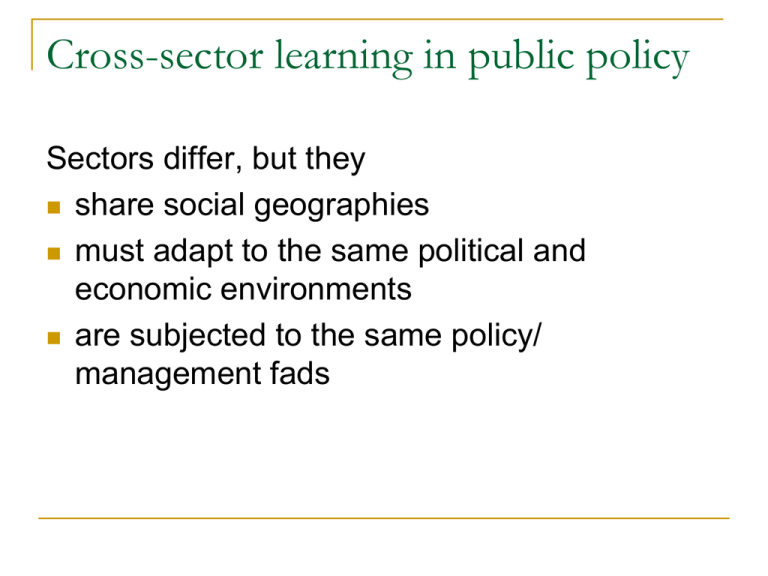Cross-sector learning in public policy
advertisement

Cross-sector learning in public policy Sectors differ, but they share social geographies must adapt to the same political and economic environments are subjected to the same policy/ management fads Cross-sector learning in public policy Cross-sector learning can illuminate assumptions suggest policy innovations by analogy; distance is good offer “pilot data” on effectiveness identify what’s promising; provide cautionary tales enrich research point to interesting questions Inform methods (measurement, design) NCLB – a case in point Federal legislation, local discretion School performance primarily assessed via high stakes testing Carrots and sticks, but sticks a prominent feature; requirement to make AYP reinforced with sanctions Expectation of rapid improvement 100% proficient by 2014 Relatively little additional funding to accomplish this NCLB – specifically re: race & ethnicity Explicit goal of achieving parity in performance No excuses; rejects the “soft bigotry of low expectations” Subgroup reporting rules Racial isolation, economic inequality, concentrated poverty not a consideration; little targeted funding Attainment of an absolute performance level, rather than improvement in performance* Illuminate assumptions Capacity Process Outcome Performance Reported performance Carrots and sticks Illuminate assumptions Capacity Process Outcome Performance Residential segregation Property tax base financing Link between race & wealth Carrots and sticks Reported performance Suggest and “pilot test” policy innovations Initial criteria for AYP based on absolute performance; recent innovations include use of gain scores confidence intervals multi-year averages “differentiated” accountability Foreshadow consequences Subgroup reporting rule requires schools to pass with all subgroups central to equity strategy but unintended consequence of identifying racially diverse schools as failing, due to propagation of Type I error “…subgroup reporting rules are analogous to a system that makes every school flip a coin for each subgroup, and then giving awards to schools that get heads on every flip” (Kane and Staiger). Kane TJ, Staiger DO. “Unintended Consequences ….” in Peterson and West, 2003. Enrich research Education research can inform HSR in Measurement issues: measuring improvement Analytic approaches: multilevel modeling – effects at the peer, teacher, school, neighborhood, school district level eg impacts of segregation at various levels Topics: Teacher salaries and teacher quality Designs (counterfactuals) End Q for audience: Journal venues? Comments: Afterward, or jan.blustein@nyu.edu Segregation by race/ethnicity Poverty and race: the typical student Student racial/ethnic composition and school performance Note: SINI is worse than AYP Kim and Sunderman Educational Researcher (2005) Avenues for action More vigorous civil rights law enforcement Identify issues and challenges faced by chronically depleted providers/organizations Identify solutions that work for chronically depleted providers/organizations, and provide targeted resources Set realistic goals (time scale; improvement rather than absolute performance) Identify and champion those that perform well against the odds

